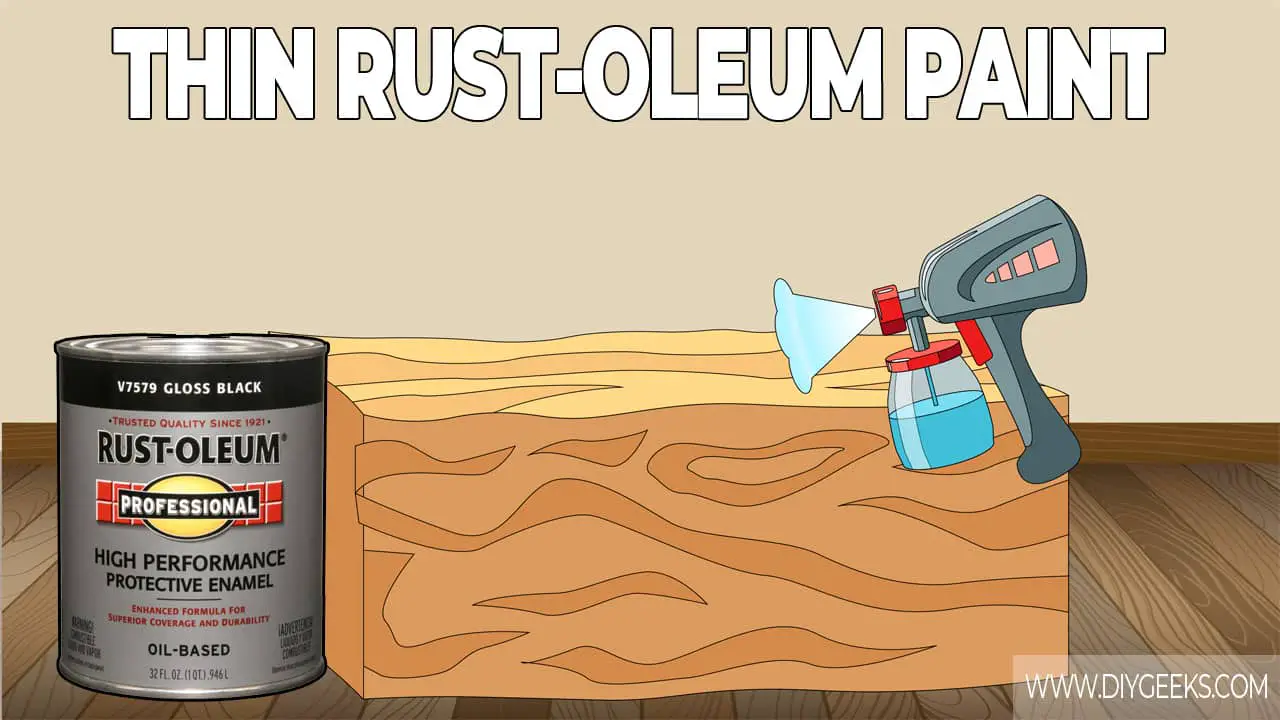Rust-oleum paints are known for their thick viscosity, durability, and ability to prevent rust over metal surfaces.
You should thin Rust-oleum paint to make paint application easier, use a paint sprayer, get a smooth finish, and speed up the paint drying time.
To thin Rust-oleum paint for spray gun, open and stir the paint, pour the paint into a bucket, add paint thinner, and test the paint.
Why Should You Thin Rust-Oleum Paint?
You should thin rust-oleum paint for the following reasons.
- To Make Paint Application Easier
- To Use a Paint Sprayer.
- To Get a Smooth Finish.
- To Speed Up Paint Dry Time.
1. To Make Paint Application Easier
Rust-oleum paint is known for its thick viscosity and hard application. If you thin Rust-oleum paint, the paint application becomes easier as you can control thinner viscosity with ease and you can use a sprayer to apply it.
2. To Use a Paint Sprayer
You can’t apply Rust-oleum paint without thinning using a paint sprayer. The paint has a thick viscosity that doesn’t fit on the spray nozzle.
If you try to spray the paint in its thick state, the paint will clog the spray nozzle making it impossible to apply it. Thinning Rust-oleum paint gives it a lighter viscosity that fits the spray paint nozzle and is applied with ease.
3. To Get a Smooth Finish
Thicker paints are harder to control and apply, so it’s harder to get a smooth and even finish. Thinned Rust-oleum paint is easier to control and apply, so you get a smoother finish.
4. To Speed Up Paint Dry Time
In its original state, Rust-Oleum paint takes too long to dry and cure because it has a thick viscosity. Thinned Rust-oleum paint takes less time to dry and cure as its thin viscosity has fewer solvents and additives that must evaporate.
What Happens if You Don’t Thin Rust-Oleum Paint Before Spraying?
If you don’t thin Rust-oleum paint before spraying, the sprayer nozzle can get clogged, the paint might develop a patchy finish, and the finish takes longer to dry.
Un-thinned Rust-oleum paint has a thick viscosity that doesn’t fit the sprayer nozzle and can clog it. Since the paint isn’t properly expelled from the sprayer, the paint can develop a patchy finish that takes longer to dry.
How to Thin Rust-Oleum Paint?
To thin Rust-oleum paint, do the following things.
- Open and Stir the Paint.
- Pour the Paint into a Bucket.
- Add the Paint Thinner.
- Test the Paint.
The tools you need for this project are listed below.
- Large paint bucket.
- Rust-Oleum paint.
- Measuring cup.
- Paint mixer or stirring stick.
- Paint thinner (Mineral spirits, acetone, or xylene).
- Spray Gun.
1. Open and Stir the Paint
Open the paint container and use a turning stick or paint mixer to gently stir the Rust-oleum paint. Stirring will loosen the paint and make it ready for thinning.
Since Rust-oleum paint is thick, its paint pigments will clump and settle into the paint container walls and bottom. You must break the clumps and stir to get a uniform consistency (or viscosity) before thinning.
2. Pour the Paint into a Bucket
Pour the needed Rust-oleum paint into a large paint bucket and stir the paint again for a few minutes (1-3). Ensure to properly seal the remaining paint onto their original container.
3. Add the Paint Thinner
The recommended paint thinners for Rust-oleum paint are acetone, mineral spirits, or xylene. The recommended ratio to thin Rust-oleum paint is 6:1 (6 ounces of paint thinner to 1 gallon of paint).
Add the needed paint thinner amount to the paint bucket and stir the paint with a stirring stick or paint mixer for around 5-10 minutes.
4. Test the Paint
Spray the thinned Rust-oleum paint over a dispensable item to check its thickness. If the paint is still thick, add more paint thinner and stir the mixture. If the paint is too thin, add more paint and stir the mixture.
If the paint comes in the right thickness, fill the sprayer and spray the paint.
Do You Need to Thin Rust-Oleum Paint Always Before Using It?
You don’t need to thin Rust-oleum paint always before using it as the paint comes in small easy-to-use spray cans that can be used for small and medium-sized projects.
You need to thin Rust-oleum paint only if spraying large surfaces, such as fences or stairs. Large surfaces require more paint and a professional paint sprayer that can’t expel the paint without thinning it first.
If you want to spray Rust-Oleum paint without thinning first, use a high-power airless paint sprayer.
Acetone vs Paint Thinner for Rust-Oleum Paint?
The differences between acetone and paint thinner for Rust-oleum paint are listed below.
- Clarity: Acetone gives the paint more clarity than paint thinner as it doesn’t contain pigments or colors. Some paint thinners made from petroleum distillates can leave a yellowish tint on the paint.
- Dry Time: Acetone evaporates faster than most paint thinners.
- Instructions: The Rust-oleum manufacturers recommend acetone as the main thinner for the paint.
Overall, acetone is a better thinning agent for Rust-Oleum paint than paint thinner because it works faster, dries in time, and produces a clearer result.


